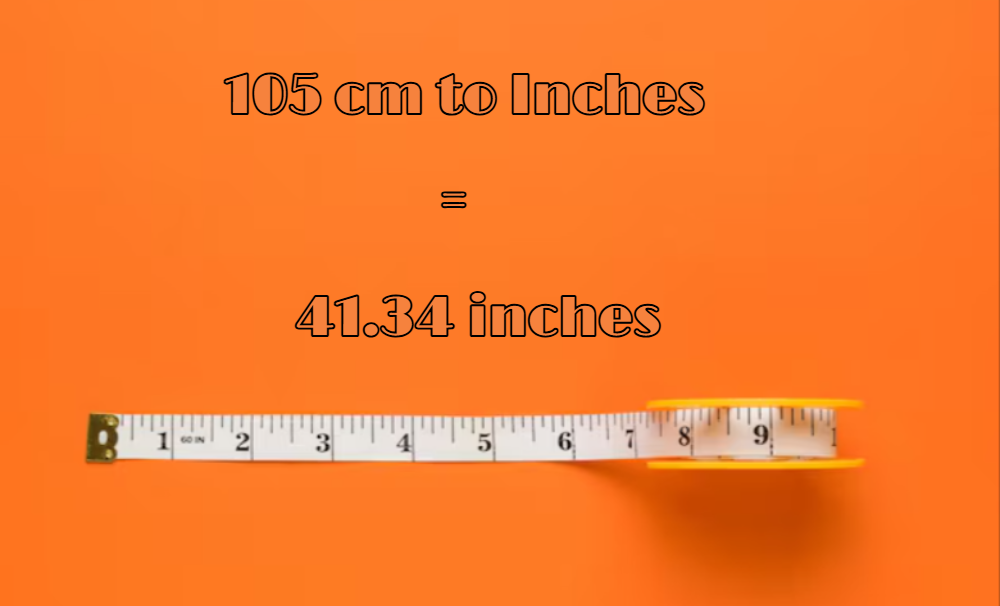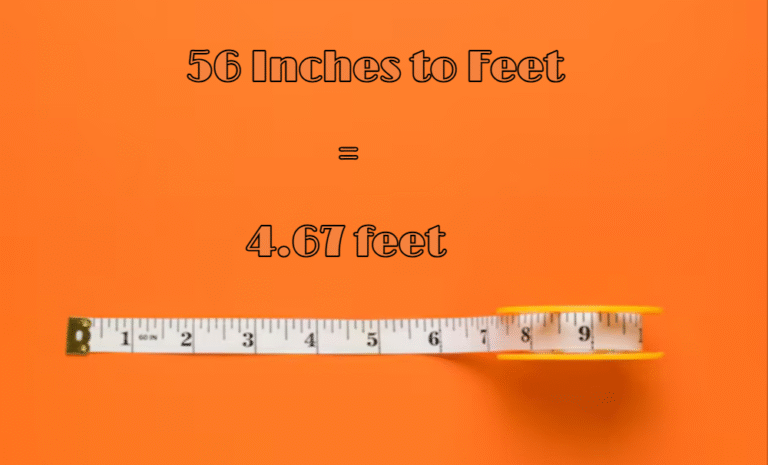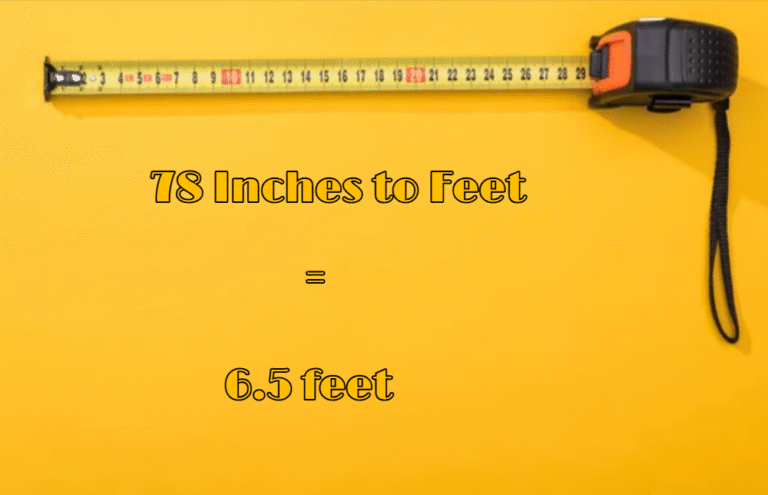
Formula to Convert 105 cm to Inches
Are you unable to convert the 105cm to inches to complete your home or school improvement project? Don’t fret I’ve got you covered by providing this easy step-by-step guide which makes the conversion of units a breeze.
Knowing how to convert centimeters into inches is a practical skill to use in daily situations, from measuring furniture to preparing recipes.
In this complete guide, I’ll guide you through how exactly to convert the measurement of 105 cm into inches using simple-to-follow steps you can follow.
What Exactly Are Centimeters and Inches?
Before we begin the process of conversion, we need to be aware of the issues we’re dealing with.
centimeters (cm) are an metric system length measurement that is widely used throughout the world.
One centimeter equals one hundredth of a meter. This makes it ideal for measuring smaller objects.
Inches On the other hand is an imperial measure that is primarily utilized within the United States.
The inch was originally described as the size of the human thumb however, today it is a scientifically precise definition.
One inch is exactly 2.54 centimeters that’s the conversion factor we’ll be using throughout this tutorial.
The relationship between centimeters and inches has been officially standardized in 1959 to ensure uniformity in international measurements.
The Quick Answer: 105 cm Equals How Many Inches?
If you’re needing to get somewhere and require a quick answer this is the solution:
105 centimeters equals 41.34 inches.
This conversion is built on the standard conversion factor, where 1 inch is 2.54 centimeters.
You now know the answer But you must discover how exactly this calculation is made and how understanding unit conversion can be important in every day life.
The Simple Formula for Converting Centimeters to Inches
Converting centimeters into inches is as simple as a mathematical formula.
To convert any measurement from centimeters to inches, just need to divide the centimeter measurement with 2.54.
The formula is like this: Inches = Centimeters 2.54 2.54
This is because an inch is exactly 2.54 centimeters.
We can apply the formula to our particular example of the 105-cm measurement:
105cm / 2.54 equals 41.34 inches
That’s it! The conversion is completed.
Step-by-Step Process to Convert 105 cm to Inches
Let me simplify the process of conversion into easy steps anyone is able to follow:
First step: Begin by measuring by centimeters (105 cm in our instance).
Step 2. Remember the conversion rate 1 inch equals 2.54 centimeters.
Step 3. Create the division equation as follows: 105 / 2.54.
4. Make the following division by 2.54 / 2.54 equals 41.34.
5. Make sure your solution is in the right unit (inches).
This is all there is to it! You’ve succeeded in changing 105 centimeters in 41.34 inches.
This method can be used to convert any centimeter measurement into inches, not only 105 centimeters.
Alternative Method: Using Multiplication Instead
Certain people prefer to use multiplication instead of division when converting.
In this case you could use this formula instead: Inches = Centimeters 0.393737 0.3937
This is because 1 2.54 / 2.54 equals 0.3937, giving us the same result using multiplication.
Let’s test this approach using our example of 105 cm example:
10 cm 0.3937 equals 41.34 inches
You can clearly see that both approaches yield the same result that is 41.34 inches.
Select the method that is most at ease for you!
Practical Examples of 105 cm in Everyday Life
To help you visualize what 105cm (or 41.34 inches) actually looks like Here are some typical measurement or objects that approximate the same length:
- The standard kitchen counter-tops are typically at 105cm (41.34 inches)
- A smaller adult bicycle could have a frame that is about 105cm
- Most coffee tables measure around the length of 105 centimeters
- The average child of 4 years old is around 105cm tall.
- Five and one-half soccer balls placed together would have a length of approximately 105 centimeters
Knowing these examples from the real world can help make the measurement more tangible and relatable.
Common Conversion Errors to Avoid
When you convert the measurement from 105 centimeters in inches (or any other measurement) Beware of these common errors:
Making use of an incorrect conversion rate Make sure your using 2.54 to convert cm-to-inch and not a different number.
Multiplication and division are often confused: Remember to divide by 2.54 when going from centimeters to inches.
Not rounding enough: Keep decimal places throughout the calculation, and only round in the last step.
In the process of labelling the answer you give: Always include the unit (inches) along with your numerical results.
Reversing the conversion Make sure that you’re doing it in the proper direction The process is different when you convert from centimeters to inches.
Beware of these errors to make sure that your conversion from the 105 centimeters to inches is precise every time.
Why Do We Need Both Measurement Systems?
It is possible to ask why we require inches and centimeters, when only one would make things easier.
The coexistence of the metric and imperial systems are mostly due to cultural and historical influences.
It was created in the French Revolution to create a sensible decimal-based system for measurement.
In the meantime, the empire’s system evolved organically over the course of centuries in England before it spread across British colonies.
Despite efforts to create a global standard on the metric system the inertia of cultures and the expense of switching have maintained both systems in use.
Industries such as manufacturing and construction in the US depend heavily on imperial measurement.
Science and commerce, however, rely on the metric system because of its simplicity based on decimal values.
Knowing both systems and how to change to them (like changing the 105 centimeters to inches) isemains an essential aspect of our ever-changing society.
Converting Other Common Measurements Related to 105 cm
Once you know what it takes to change 105cm into inches we’ll look into some other conversions that may be helpful:
- The conversion to feet is: 105 cm = 3.44 feet (since 1 foot is 30.48 centimeters)
- Converting to yards: 105 cm = 1.15 yards (since 1 yard = 91.44 cm)
- The conversion to meters is: 1 meter = 105 centimeters 1.05 meters (since 1 meter is 100 centimeters)
- Half of 105 centimeters: 52.5 cm = 20.67 inches
- Double 105cm: 210 cm = 82.68 inches
These conversions are beneficial in many scenarios, from home improvements to crafting projects.
Digital Tools for Quick Conversions
Knowing how to convert manually the measurement of 105 centimeters into inches is beneficial however, there are numerous digital tools to help speed up the process:
- Smartphone Applications: Many free conversion apps are available on both Android as well as iOS devices.
- Voice assistants It is possible to ask Siri, Google Assistant, or Alexa to convert your measurements for you.
- Online calculators: Web sites like Calculator.net or ConvertUnits.com provide easy interfaces for rapid conversions.
- Spreadsheet functions: Programs like Excel or Google Sheets have built-in conversion formulas.
- Smartphones for Smart Homes: Many smart displays are able to convert via voice commands.
These tools are especially useful in situations where you must change multiple measurements quickly, or if you don’t have a calculator on hand.
The Importance of Understanding Unit Conversions in Education
Converting measurements such as 105cm to inches isn’t only practical. It’s also educational.
Teachers of math are particularly keen on unit conversions as they help reinforce a number of important math concepts:
- Proportional reason: Conversions rely on knowing the relation between various units.
- Multiplication and division The conversion process teaches these fundamental functions.
- Decimal operation: Working with conversion factors such as 2.54 is a math problem that requires decimal numbers.
- The concept of critical thinking is Knowing the formula you should apply develops problem-solving capabilities.
- Applications in the real world: Unit conversions bridge abstract math and practical application.
Research has shown that students who are proficient in unit conversion generally perform better in general mathematics since the concepts transfer across different areas.
If you’re learning to convert 105cm to inches in the process, you’re building greater mathematical knowledge!
Professional Fields Where CM-to-Inch Conversions Matter
Converting measurements such as 105cm in inches is vital in many fields of professional work:
- Architecture and construction Blueprints can employ either method based on the country of origin, and requires constant conversion.
- Fashion and Textile Industries: Clothing patterns and measurements of fabrics often require conversion between different systems.
- Engineering Globally produced parts might use different measurements standards.
- Medical: Equipment for medical use and patient measurements may require conversion between different systems.
- Furniture Design Designs for markets in the international market need to be sized within both of the systems.
- Academic Research Research papers usually employ metric measurements, however they may require conversion to imperial for certain groups.
Professions in these fields must be adept at converting between measurement systems in order to guarantee accuracy and avoid costly errors.
DIY Projects Using 105 cm/41.34 Inches
If you’re in search of practical ways to measure a distance of 105 centimeters (41.34 inches), here are some ideas for DIY projects:
- bookshelf height: A height of 105 centimeters makes the perfect bookshelf that fits under the majority of windows.
- coffee table design: An espresso table that measures 105cm is suitable for the majority of living space arrangements.
- Children’s Desk: 105cm is a great length for a child’s study desk.
- Wall Art Installation: Use the 105 cm measurement to guide you for hanging artwork to the correct viewing level.
- Garden Bench: A garden bench about 105 cm wide comfortably seats two adults.
While working in these areas, understanding that 105 centimeters equals 41.34 inches will help you work more accurately using either measurement system.
Teaching Children About Measurement Conversions
If you’re assisting your child learn the process of converting 105 centimeters to inches Try these child-friendly strategies:
- Utilize Visual aids Display them a measuring stick that has centimeters as well as an inch ruler in a row.
- Have them do it in a hands-on way: Have them measure objects with both systems, and then evaluate.
- Create a rhyme that is simple: “To find inches from centimeters divide it by two points 5-4.”
- Make it into a game The challenge is to find items in the home which measure up to 105cm.
- Connect with their areas of interest: If they like sports, then discuss how the athlete’s heights are typically included in both systems.
- Make use of common references: Explain that 105 cm is roughly as tall as they were at four years old.
These strategies can make learning conversions more interesting and memorable for learners who are young.
Quick Reference Chart: CM to Inches Around 105 cm
Here’s a guide to measurements in the vicinity of 105cm converted to inches:
| Centimeters | Inches |
|---|---|
| 100 cm | 39.37” |
| 101 cm | 39.76” |
| 102 cm | 40.16” |
| 103 cm | 40.55” |
| 104 cm | 40.94” |
| 105 cm | 41.34” |
| 106 cm | 41.73” |
| 107 cm | 42.13” |
| 108 cm | 42.52” |
| 109 cm | 42.91” |
| 110 cm | 43.31” |
This chart can be particularly helpful for those working with measurements that are close to the 105cm mark and require rapid conversions, without having to recalculate.
Cultural Differences in Measurement Preferences
It’s interesting to study the different ways that different cultures interact with measurement systems.
In Europe the system of metric (centimeters) is utilized almost exclusively in daily life.
Americans tend to use imperial measurements (inches) for everyday routine tasks, and struggle often with conversions to metric units.
Countries that have British influence usually utilize a combination of the two systems resulting in distinctive measurement systems.
A lot of Canadians and Brits can switch between the two systems quickly, using metric for certain things, and imperial for other things.
Scientists around the world utilize the metric system irrespective of their country’s daily preference.
Understanding these cultural differences can to explain why knowing the meaning of the different conversions (like the ratio of 105 cm in 41.34 inches) is important in our world.
Common Questions About Converting 105 cm to Inches
Let’s look at some frequently asked questions regarding this particular conversion:
Is 105cm precisely 41.34 inches?
Yes, when measured precisely using the standard conversion coefficient that is 2.54 centimeters per inch.
What should I do? Should I turn 41.34 inches into 41.3 instead of 41.4 inches?
It’s all about your accuracy. For most purposes, 41.3 inches is sufficient.
how tall 105cm by inches and feet?
105 centimeters equals 3.34 feet 5.34 inches (3’5.34 ”).
Is 105cm taller than the average for specific groupings of people?
A height of 105cm is roughly the height average of a 4-year-old child.
What’s the simplest way to keep track of what the percentage of conversion is?
Keep in mind that 2.54 is equivalent to 2 1/2 centimeters, which means that an inch equals two centimeters.
What is the size of 105 centimeters within the US?
The measurement of 105 centimeters is roughly 41.3 inches. In US sizes, this could be a men’s Large or women’s XL depending on the area of measurement.
What is the equivalent of 105 inches? 105 centimeters?
105 cm equals 41.34 inches. (Conversion 1 cm equals 0.3937 inches)
What is the number of centimeters in a 32-inch waist?
A waist of 32 inches is approximately 81.28 inches. (Conversion 1 inch equals 2.54 cm)
What is 100cm equivalent to inches?
100 centimeters is 39.37 inches. (Standard conversion of imperial to metric)
What size of breast is 105cm?
105 cm is the measurement for underbust or bust measurement. In EU sizes it can mean 105B/C/D according to the size of your cup.
What is the size of XL?
The XL (Extra Large) generally fits chest sizes of between 42 and 44 inches (106-112 cm) for men or 16-18 US for women. It varies according to the brand.
These questions should to clarify common misunderstandings concerning the conversion of from 105cm into inches.
Conclusion
Converting from 105cm to inches does not have to be difficult.
By simply dividing 2.54, you can quickly calculate that the 105 centimeters equal 41.34 inches.
This practical knowledge is beneficial in many real-world scenarios, such as home renovations to overseas travel.
If you’re a student studying measurement systems, a home-maker creating projects, or simply trying to comprehend the dimensions of a product from a different nation Mastering this conversion opens the doors.
Keep in mind that in this ever-changing world, being able to use imperial and metric measurements is more essential than ever before.
The next time you see the number in 105cm and you’ll be able to know what it is in inches without a doubt!
Additional Resources for Measurement Conversions
If you’re interested in exploring the measurement conversion process further take a look at these resources:
- The National Institute of Standards and Technology (NIST) website provides detailed information on measurement systems.
- Khan Academy provides free educational videos on unit conversions
- Mobile apps such as “Unit Converter” or “Converter+” can handle a variety of kinds of conversions
- For students, websites like Mathway and Wolfram Alpha can show the step-by-step procedure for any conversion.
- Local libraries typically have reference materials, which include tables and charts of conversion
These tools will aid you in the conversion of the 105cm into inches as well as all the measurement conversions that you could require in everyday life.

